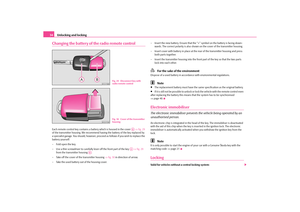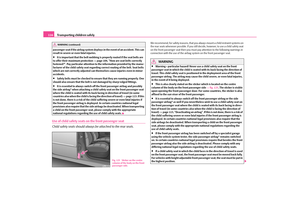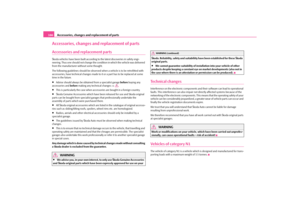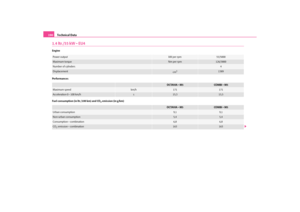Page 49 of 207

Lights and Visibility
48
Headlamp range adjustment
Once the low beam is switched on you can then adapt the range of the
headlights to the lo ad of the vehicle.– Turn the control dial fig. 43 until you have adjusted the low beam so that
oncoming traffic is not dazzled.
Settings
The positions correspond approximately to the following vehicle loads:
Front seats occupied, luggage compartment empty.
All seats occupied, luggage compartment empty.
All seats occupied, luggage compartment laden. Driver seat occupied, lu ggage compartment laden.
Caution
Set the headlight beam adjustment in such a way as to avoid dazzling oncoming traffic.
Note
Headlights fitted with Xenon bulbs adapt auto matically to the load and driving state of
the vehicle (e.g. accelerating , braking) when the ignition is switched on and when
driving.
Switch for hazard warning lights
– Press switch
fig. 44 to switch the hazard warning light system on or off.
All the turn signal lights on the vehicle flas h at the same time when the hazard warning
light system is switched on. The indicator light for the turn signals and the indicator
light in the switch also flash at the same time. You can also switch on the hazard
warning light system if the ignition is switched off.
The hazard warning light system is switched on automatically if an airbag is deployed
in the event of an accident.
Please comply with any legal requirements when using the hazard warning light
system.
Note
Switch on the hazard warning light system if, for example:
you encounter traffic congestion,
your vehicle breaks down or an emergency situation occurs.
Fig. 43 Dash panel: Lights and
Visibility
A-AIAIIAIII
Fig. 44 Dash panel: Switch for
hazard warning lights
s2rc.book Page 48 Thursd ay, April 22, 2010 10:58 AM
Page 50 of 207

Lights and Visibility49
Using the system
Safety
Driving Tips
General Maintenance
Breakdown assistance
Technical Data
The turn signal
and main beam lever
The parking lights and headlight flas her are also switched on and off
using the turn signal and main beam lever.The turn signal and main beam le ver perform the following functions:Right
and left
turn signal light
– Push the lever upwards or downwards fig. 45 .
– Turn signal for changing lanes - in order to only flash briefly, move the lever up or
down to the pressure point and hold it in this position.Main beam
– Switch on the low beam.
– Push the lever forwards.
– Pull the lever back into the initial positi on in order to switch the main beam off
again.Headlight flasher
– Pull the lever towards the steering wheel (spring-tensioned position) - the main
beam and warning light in the instrument cluster come on.
Parking light
– Switch off the ignition.
– Push the lever up or down - the right-hand or left-hand parking light is switched
on.
Information concerning the function of the lights.
The turn signal system only operates when the ignition is switched on. The corre-
sponding warning light
or in the instrument cluster also flashes.
The turn signal is automatically cancelled after negotiating a curve.
The indicator light flashes at twice its normal rate if a bulb of the turn signal light
fails.
The side light and rear light on the appropriate side of the vehicle are switched on
when the parking light is selected. The parking light function only operates if the igni-
tion is switched off.
An acoustic warning signal will sound when the driver's door is opened if the lever
is not in the middle position after removi ng the ignition key. The acoustic warning
signal will stop just as soon as the driver's door is closed.Caution
Use main beam or the headlight flasher only if this does not risk dazzling other road
users.
Note
Use only in accordance with the legal requ irements the described lighting and signal
systems.Coming Home Function*This function makes it possible to switch on low beam for a short time after leaving the
car, e.g. to illuminate the path to your front door, etc.Selecting function– Switch off the light.
Fig. 45 Turn signal and main
beam lever
s2rc.book Page 49 Thursd ay, April 22, 2010 10:58 AM
Page 51 of 207

Lights and Visibility
50
– Switch off the ignition.
– Operate the headlight flasher once.
– Open and close the driver door.
If the door remains open, the light remains on for about 3 minutes.
If the door remains closed, the light stays on for about 30 seconds.Interior lightingFront interior lighting and lighting of storage compartment on front passenger sideSwitching the interior light on– Press the switch to the left, the symbol
fig. 46 appears.
Switching the interior light off– Press the switch into the middle position O.
– On the version without reading lights press the switch to the right, the symbol O appears.Door contact switching mechanism (front and rear* doors)– Press the switch to the right, the symbol
appears. – On the version without reading lights press the switch into the middle position
.
Reading lights*– Press on one of the switches in order to
switch the right or left reading light on
or off.Lighting of storage compartment on the front passenger side*– When opening the flap of the storage comp artment on the front passenger side the
lighting in the storage compartment comes on.
– The light switches on automatically when the parking light is switched on and goes
out when the flap is closed.
On vehicles with central locking, the interior light is switched on for about 20 seconds
when the vehicle is unlocked, when a door is opened or after withdrawing the ignition
key (if the switch of the relevant interior light is in the door contact position).
The interior lighting goes off after about 60 minutes when a door has been left open in
order to avoid discharging the battery of the vehicle.
Note
We recommend having these bulbs re placed by a specialist garage.Rear interior lighting*
Fig. 46 Detail of the headliner:
front interior lighting
AAAA
AA
AA
AA
AB
Fig. 47 Rear light
s2rc.book Page 50 Thursday, April 22, 2010 10:58 AM
Page 52 of 207

Lights and Visibility51
Using the system
Safety
Driving Tips
General Maintenance
Breakdown assistance
Technical Data
The rear interior lighting
page 50, fig. 47 is switched on and off by pressing the glass
on the indented point.
The same principles apply for the interior ligh ting at the rear as for the for the interior
lighting at the front page 50.
Note
We recommend having the bulb replaced by a specialist garage.Luggage compartment light*The light is located at the left top side of the (right - Combi) luggage compartment.
The lighting comes on automatically when th e boot lid is opened. If the lid remains
open for more than about 30 minutes, the luggage compartment lighting switches off
automatically.VisibilityRear window heater– You can switch the rear window heater on or off by pressing the switch
fig. 48
- the indicator light in the switch comes on or goes out.
You can only activate the rear window he ater when the ignition is switched on. On vehicles with electrically operated power windows, the exterior mirror heater is
also switched on at the same time when
the rear window heater is activated.
For the sake of the environment
As soon as the window is de-iced or free from mist, the heating should be switched off.
The reduced current consumption will have a favourable effect on fuel economy
page 132, “Saving electricity”.Sun visorsThe sun visors can be pulled out of the fixtures and swiveled towards the side window.
The visor above the interior mirr or* can only be folded down. fig. 49 .
Sun visors with lighting*
After folding down the visor, the lighting for the vanity mirror is switched on.
Fig. 48 Switch for rear window
heater
Fig. 49 Sun visor: swivelling out
s2rc.book Page 51 Thursd ay, April 22, 2010 10:58 AM
Page 53 of 207

Lights and Visibility
52
Windshield wiper and wash systemWindshield wiper
You can operate the windscreen wipers and automatic wipe/wash
using the windscreen wiper lever.The windscreen wiper lever fig. 50 has the following positions:Finger-operated wiping– If you wish to wipe the windscreen only briefly, push the lever into the sprung
position .Intermittent wiping– Position the lever up into position .
– Set with the switch the desired break between the individual wiper strokesSlow wipe– Position the lever up into position .Fast wipe– Position the lever up into position .
Automatic wipe/wash for windscreen– Pull the lever towards the steering wheel into the spring-tensioned position , the windscreen wiper and wash system will operate immediately.
– Release the lever. The windscreen wash system stops and the wiper continues for another 1 - 3 wiper strokes (depending on the period of spraying of the wind-
screen).Rain sensor*– Move the lever into position .
– You can set the sensitivity of the sensor individually with switch .
– After switching off the ignition, you must then once again activate the sensor by moving the lever into position , and then back into position .Wiping the rear window pane*– Push the lever away from the steering wheel into position - the widescreen
wiper will operate every 6 seconds.Automatic wipe/wash for the rear window pane*– Push the lever away from the steering wh eel into the spring-tensioned position ,
the windscreen wiper and wash system will operate. As long as you hold the lever
in this position, the wiper and the wash system operate - spring-tensioned posi-
tion.
– Letting go of the lever will cause the windscreen wash system to stop and the wiper to continue for another 1 - 3 wiper strokes (depending on the period of spraying of
the windscreen). The lever will stay in position after releasing it .Switching windscreen wipers off– Move the lever back into its home position .
The windscreen wipers and the windscreen washer system only operate if the ignition
is switched on.
The rain sensor* automatically regulates the break between the individual wiper
strokes depending on the intensity of the rain.
Fig. 50 Windscreen wiper lever
A4
A1
AA
A2A3
A5
A1
AA
A0
A1
A6
A7
A6
A0
s2rc.book Page 52 Thursd ay, April 22, 2010 10:58 AM
Page 54 of 207

Lights and Visibility53
Using the system
Safety
Driving Tips
General Maintenance
Breakdown assistance
Technical Data
The windscreen washer nozzles for the windscreen are heated* when the ignition is
switched on.
Top up with wash liquid
page 159.
WARNING
Properly maintained wind screen wiper blades are essential for clear visi-
bility and safe driving page 53, “Replacing wiper blades for the windscreen
wipers”.
Do not use the windscreen washer sy stem at low temperatures, without
heating the windscreen beforehand. Otherwise the window cleaner could
freeze on the windscreen and re strict the view to the front.
The rain sensor only operates as a support. The driver is not released from
the responsibility to set the function of the windscreen wipers manually
depending on the visibility conditions.Caution
In frosty weather, please firs t of all check whether the windscreen wiper blades are not
frozen to the windscreen before switching them on. Switching on windscreen wipers
when the blades are frozen to the windscreen may result in damage both to the blades
and the motor of the windscreen wipers!Replacing wiper blades for the windscreen wipers
Taking off the wiper blade– Fold windscreen wiper arm out from the windscreen and position the wiper blade at right angles to the wiper arm .
– Press the securing spring in the directio n of arrow and press the wiper blade at
the same time to the windscreen - Wa rning, danger of breaking the wind-
screen. fig. 51 .Attaching a wiper blade– Clip the securing spring until it is heard to lock in the windscreen wiper arm.
– Check whether the wiper blade is correctly attached.
Wiper blades in proper condition are essentia l to obtain good visibility. Wiper blades
should not be allowed to become dirtied by dust, insect remains and preserving wax.
Juddering or smearing of the wiper blades co uld then be due to wax residues left on
the windscreen by vehicle wash ing in automatic vehicle wash systems. It is therefore
important to degrease the lips of the wiper blades after every pass through an auto-
matic vehicle wash system .
WARNING
If the windscreen wipers are handled ca relessly, there is a risk of damage to
the windscreen.
You should clean the wiper blades regularly with a windscreen cleaner in
order to avoid any smears. Clean a wiper blad e with a sponge or cloth if it is very
dirty, for example fr om insect residues.
Replace the wiper blades once or twice a year for safety reasons. The wiper
blades are available fr om specialist garages.
Fig. 51 Wiper blade for the
windscreen wiper
AA
AB
s2rc.book Page 53 Thursd ay, April 22, 2010 10:58 AM
Page 55 of 207

Lights and Visibility
54
Replacing the wiper blade for rear window (Octavia)*Taking off the wiper blade– Fold the window wiper arm away fig. 52 .
– Hold the window wiper arm at the top end with one hand.
– Take hold of the wiper blade in the midd le with the other hand and take off the
wiper blade by moving in direction of arrow .Attaching a wiper blade– Interlock the wiper blade into th e window wiper arm - see arrow .
– Check whether the wiper blade is correctly attached.
The same remarks apply here as for page 53, “Replacing wiper blades for the wind-
screen wipers”.Rear-view mirrorManual dimming interior rear-view mirrorAdjust the rear mirror before commencing to drive so that there is a clear view to the
rear.
Basic setting– Pull the lever on the bottom edge of the mirror forward.Dimming mirror– Pull the lever on the bottom edge of the mirror back.Exterior mirrorThe heating of the external mirror functi ons only when ignition is switched on.
Electrically adjustable exterior mirrors*
Carry out the adjustment at the set button ne xt to the inner door handle when the igni-
tion is switched on fig. 53 .
Position
Heating of the exterior mirrors (only on ve hicles with electrically operated power
windows).
Position L
Operating the left and right mirr ors at the same time (valid for vehicles with electrically
operated power windows).
Operating the left mirror (valid for vehicles without electrically operated power
windows).
Fig. 52 Wiper blade for rear
window
AB
AA
Fig. 53 Inner part of door:
Rotary knob
s2rc.book Page 54 Thursd ay, April 22, 2010 10:58 AM
Page 56 of 207
Lights and Visibility55
Using the system
Safety
Driving Tips
General Maintenance
Breakdown assistance
Technical Data
Position R
Operating the right mirror.
WARNING
Convex (curved outward) or spherical (differently curved) exterior mirrors
increase the vision field. They do, howe ver, make objects appear smaller in the
mirror. These mirrors are only of limi ted use, therefore, for estimating
distances to the following vehicles.
Use whenever possible the interior rear mirror, for estimating the distances
to the following vehicles.Note
Do not touch the surfaces of the exterior mirrors if the exterior mirror heater is
switched on.
You can set the exterior mirr ors by hand, if the power setting function fails at any
time by pressing on the edge of the mirror surface.
Contact your specialist garage if a fault ex ists with the power setting of the exterior
mirrors.
s2rc.book Page 55 Thursd ay, April 22, 2010 10:58 AM
 1
1 2
2 3
3 4
4 5
5 6
6 7
7 8
8 9
9 10
10 11
11 12
12 13
13 14
14 15
15 16
16 17
17 18
18 19
19 20
20 21
21 22
22 23
23 24
24 25
25 26
26 27
27 28
28 29
29 30
30 31
31 32
32 33
33 34
34 35
35 36
36 37
37 38
38 39
39 40
40 41
41 42
42 43
43 44
44 45
45 46
46 47
47 48
48 49
49 50
50 51
51 52
52 53
53 54
54 55
55 56
56 57
57 58
58 59
59 60
60 61
61 62
62 63
63 64
64 65
65 66
66 67
67 68
68 69
69 70
70 71
71 72
72 73
73 74
74 75
75 76
76 77
77 78
78 79
79 80
80 81
81 82
82 83
83 84
84 85
85 86
86 87
87 88
88 89
89 90
90 91
91 92
92 93
93 94
94 95
95 96
96 97
97 98
98 99
99 100
100 101
101 102
102 103
103 104
104 105
105 106
106 107
107 108
108 109
109 110
110 111
111 112
112 113
113 114
114 115
115 116
116 117
117 118
118 119
119 120
120 121
121 122
122 123
123 124
124 125
125 126
126 127
127 128
128 129
129 130
130 131
131 132
132 133
133 134
134 135
135 136
136 137
137 138
138 139
139 140
140 141
141 142
142 143
143 144
144 145
145 146
146 147
147 148
148 149
149 150
150 151
151 152
152 153
153 154
154 155
155 156
156 157
157 158
158 159
159 160
160 161
161 162
162 163
163 164
164 165
165 166
166 167
167 168
168 169
169 170
170 171
171 172
172 173
173 174
174 175
175 176
176 177
177 178
178 179
179 180
180 181
181 182
182 183
183 184
184 185
185 186
186 187
187 188
188 189
189 190
190 191
191 192
192 193
193 194
194 195
195 196
196 197
197 198
198 199
199 200
200 201
201 202
202 203
203 204
204 205
205 206
206






